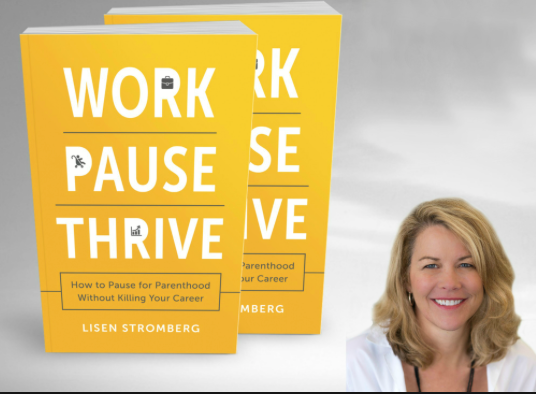
Did you know that currently there are 5 million empty jobs in the U.S. waiting for someone to fill them? Today, 47% of the workforce are women. But if we don’t encourage and enable more to get into that workforce, who will fill those empty jobs — 657,000 of which are in IT? Perhaps Lisen Stromberg’s new book, “Work Pause Thrive,” has some answers.
I have just finished reading it and now know why it is turning into such a big seller. It is great! I interviewed Stromberg just before the book was published and during our conversation, we realized that our professional lives have a great deal in common. I managed my career, raised my family and even cared for parents without a pause. And like Stromberg, I managed to thrive. Her book was a real eye-opener into what people of my generation just assumed was “the way it is” — but need not be for the future.
Early on, Stromberg learned that it was really hard to pursue a career in advertising and marketing while she was raising her family. She paused, pivoted and became an award-winning journalist. Along the way, she realized that other women were struggling with the same choices. Could they pursue a career and have children or was it an either/or that would forever change their career growth and personal lives?
Like a true entrepreneur, Stromberg determined that maybe it didn’t have to be this way. Maybe it was time, finally, to rethink how to balance home and work in a culture that devalues the caregiving roles we all must perform at some stage in our lives. With the growing dependence of parents on their children, typically their daughters, she recognized that the work/family conundrum was quickly demanding a realistic answer, and fast.
So what did Stromberg do? First, she conducted research, surveying 1476 women (and a handful of men) and interviewing 186 women, seeking to discover how women (and even some men) are arranging their lives so they can “have it all” — but their way. The key? A more balanced lifestyle, one that takes into account the needs of the workplace and those of the workers.
As it turns out, Stromberg’s research was very timely. In the U.S., we are becoming a nation of women breadwinners. In fact, we have been moving in this direction for decades, way before the 2008 recession, and from society's perspective, this is a tipping point. Today, women represent almost half (47%) of the American workforce.
Data from The Center for American Progress (shown below) shows that there is a significant transformation in how women work, which women are working, and why it has become essential for them to have paid employment. And the shift is accelerating. Case in point: Pew Research found that the vast majority of Americans (79%) do not see women as returning to traditional roles.
The data is very important in terms of the underlying trends:
- The employment rate of married mothers with children has increased from 37% in 1968 to 65% in 2011.
- Mothers’ views about whether and how much they would like to work has changed significantly, after welfare reform and with more women getting a college education.
- The percentage of women who believe their ideal situation would be to work full-time increased from 20% in 2007 to 32% in 2012. And the percentage of mothers who would prefer not to work at all fell from 29% to 20%.
- In 40% of U.S. households with children, mothers are the sole or primary provider of income—the major breadwinner.
These sole-earner moms fall into two groups with very different needs and of distinctive socioeconomic and ethnic makeup.
- 5.1 million (37%) are married mothers with a higher income than their husbands and are usually highly educated professionals.
- 8.6 million (63%) are single mothers, typically African-American, Latino and other minorities.
If women in the workforce have therefore become an irrefutable and growing entity, how can the workplace be transformed into one where women and men can perform across all their roles—home, work, family and their communities? Stromberg believes the solution is to change the workplace culture, focusing less on women’s work/family needs as a problem to solve and more on creating a better work environment for everybody in order for businesses to thrive.
In “Work Pause Thrive,” Stromberg shares many stories of women who forged non-linear career paths after raising children and returning to the workforce. Yet far too often, the business community saw these paths as a step-down, a depreciation of these women’s skills and value. Reentry was often difficult or non-existent, causing them to seek freelance positions, start home-based businesses or launch companies. In fact, since the 2008 recession, women own 36% of all businesses in the U.S. and have been the business growth engine for the economy, as this research captures for us.
What’s truly significant about Stromberg’s theories is that they do not apply merely to high-income women from elite colleges. Rather, they speak to all types of women: breadwinner moms trying to hold onto a job while caring for their family, single moms raising children alone, and working moms trying to keep their heads above water along with their partner or spouse. Her solution was to launch PrismWork, a culture innovation consulting practice that works with organizations to attract, retain and promote women and other under-represented talent.
And guess what happens when women workers are valued, empowered, allowed to pause, and then warmly embraced when they return to their careers? Organizations benefit — no, they thrive — from this hidden pool of high caliber talent.
Why? It’s actually very clear. Women need the workplace and the workplace needs women.
